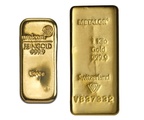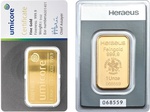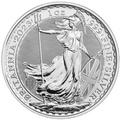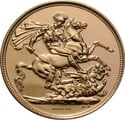Gold - Silver Ratio
The
Gold - Silver Ratio
represents the number of ounces of silver it takes to purchase one ounce of gold. For example, if gold was trading at £950 and silver was priced at £12.50, the gold : silver ratio would be 76. The gold - silver ratio offers a useful look at the relationship between the two primary investment metals, and can point to some potential movement for the metals in the future.

By using
the latest Gold to Silver ratio charts,
investors can see how many ounces of silver would equate to one ounce of gold. The logic is that when the ratio is wider, silver is undervalued, and when the ratio is narrower then gold is undervalued. This is a rough approximation, but investors still use the gold - silver ratio as jigsaw data - combining it with other factors such as demand and the amount mined to work out whether either metal could be due for a price rise.
The typical range of gold to silver is between 50 and 70, so if the ratio is sitting comfortably around the 80 mark, this suggests the time could be right to buy silver.
Throughout history the ratio has fluctuated widely.
- In 2020 the ratio peaked at 123.5
- At the peak of the last precious metals boom in 1980 the ratio had narrowed to 17
- At the end of the 19th century the ratio was fixed at 15
- During the Roman Empire the ratio was fixed at 12
- 323 B.C. at the time of Alexander the Great's death the ratio stood at 12.5
Many investors in silver believe the ratio should stand at 16:1, primarily because there is 16 times more silver in the Earth’s crust than gold.
Many argue that the ratio could fall further because only 9 times more silver is currently being mined globally than gold. Others point to the fact there is 160,000 tonnes of gold above ground whilst most of the silver ever mined has been used up in industrial processes.
View the
gold - silver ratio
and the
silver - gold ratio.
- How To Buy Gold
- How to Buy?
- Payment Options
- Delivery Options
- Gold Storage
- Storage at Brink's
- Gold Investment Guide
- Why buy gold?
- Is gold a good investment?
- Why physical gold?
- Best time to buy gold?
- Gold bars vs coins?
- Gold vs Silver
- Gold - Silver Ratio explained
- VAT on bullion
- CGT on bullion
- Legal tender coins
- Top 5 Gold Investments
- Top 5 Silver Investments
- Gold vs ISAs
- Gold vs Buy-to-Let
- Gold vs FTSE 100
- Gold vs Bitcoin
- Where to buy gold?
- Why buy from us?
- Where to sell gold?
- Coin Shops
- Gold Price Forecasts
- Top 10 Gold Producers
- Top 10 Gold Reserves
- Gold Britannia vs Sovereign
- Britannia coin designs
- Sovereign coin designs
- Sovereign Mintages
- Sovereign mint marks
- British coin specs
- What is a proof coin?
- Royal Mint bullion
- The Queen's Beasts
- Royal Mint Lunar Coins
- Bullion Refiners
- British coin mints
- Krugerrands
- Gold Tola - India & Pakistan
- Bullion Index















